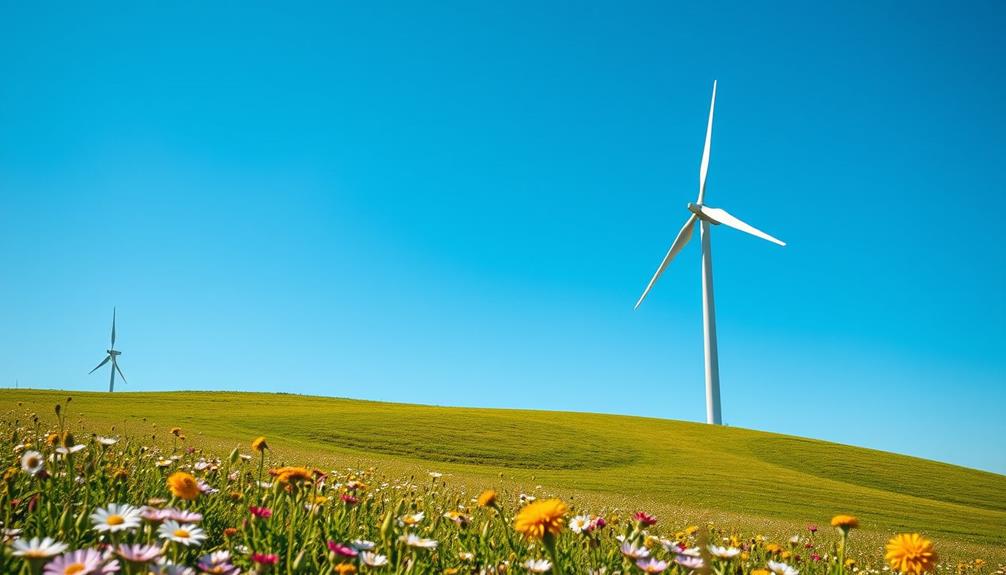Harnessing wind energy for your home is a smart way to cut electricity costs and boost energy independence. Start by evaluating your site's average wind speed; it should exceed 9 mph for effectiveness. Choose a turbine size based on your energy needs, typically between 5 kW to 15 kW for a regular home. After installation, regular maintenance guarantees ideal performance and longevity. Look into local zoning regulations and available incentives to make the process smoother and more affordable. Ready to explore more about harnessing the power of the wind and maximizing your energy potential? Wind power benefits extend beyond just reducing electricity costs. By harnessing wind energy, you can also reduce your carbon footprint and contribute to a more sustainable future. Additionally, wind power systems can provide energy security, as they are not reliant on fuel imports or vulnerable to supply chain disruptions. Embracing wind power for your home not only makes financial sense but also aligns with environmental and energy independence goals.
Key Takeaways
- Assess your site for average wind speeds above 9 mph and ensure a clear area around the turbine for optimal performance.
- Choose the appropriate turbine size (5-15 kW) based on your energy consumption and local wind conditions.
- Understand local zoning regulations and obtain necessary permits before installation to ensure compliance.
- Regular maintenance and inspections every 6 months can extend the lifespan and efficiency of your wind turbine.
- Take advantage of financial incentives like tax credits to reduce installation costs and enhance long-term savings on energy bills.
Overview of Wind Energy Systems
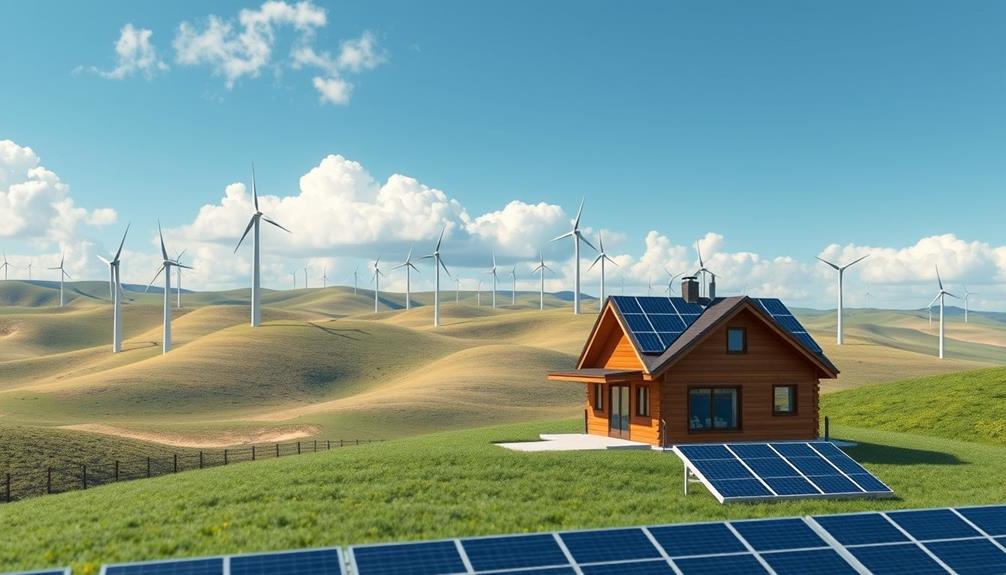
Wind energy systems, particularly small wind electric systems, are designed to harness the power of the wind to provide clean, renewable energy for your home. These systems typically consist of a wind turbine, tower, charge controller, and batteries, aimed at supplementing or reducing your reliance on grid power.
To effectively meet your monthly energy needs of around 300 kWh, a 1.5 kW wind turbine requires an average annual wind speed of 14 mph. The weight of wind turbine blades can vary greatly, impacting transportation and installation logistics; understanding this can help in selecting the right system for your needs.
The installation cost of small wind electric systems can vary, but the benefits include lower electricity bills and increased energy independence. To guarantee peak performance, proper site assessment is essential. You'll need geographical conditions that support a minimum average wind speed of 9 mph.
Wind energy is the second-largest renewable energy source in the US, and these systems not only generate energy but can also enhance grid stability by feeding energy back into the electrical grid. Additionally, they offer the potential to store energy or feed it back into the electrical grid, providing you with more flexibility and control over your energy generation.
Benefits of Home Wind Turbines
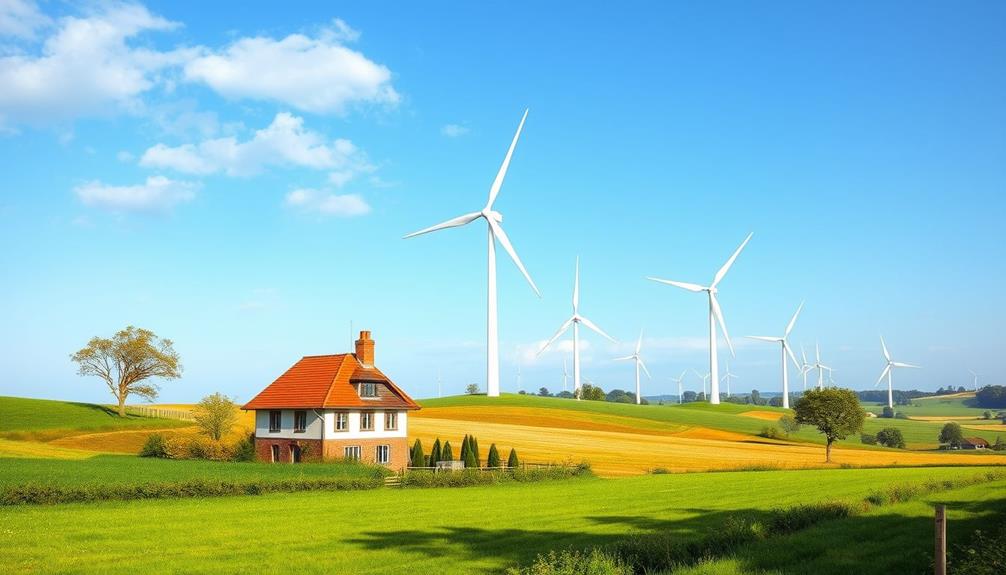
Home wind turbines offer numerous advantages that make them an appealing energy solution for homeowners. By harnessing wind energy, you can generate clean, renewable electricity right at your home, greatly reducing greenhouse gas emissions and promoting a sustainable future.
Additionally, as you produce your own energy, you'll likely see long-term savings on your energy bills, with reductions of 50-90% after the payback period, which averages around 15 years. This aligns with the growing trend towards natural remedies alongside conventional medications for sustainable living.
Using small wind turbines not only enhances your energy independence but also helps you mitigate vulnerability to fluctuating utility rates and outages. This self-sufficiency can provide peace of mind and financial stability.
Furthermore, installing these turbines can increase your property's value, making them a smart investment for those looking to adopt renewable energy sources.
Financial incentives, such as tax credits and grants, can lower your installation costs by up to 30%, making home wind turbines a more accessible option for many households.
With these benefits, investing in wind energy for your home isn't just environmentally friendly—it's also a strategic financial decision.
Installation Process and Requirements
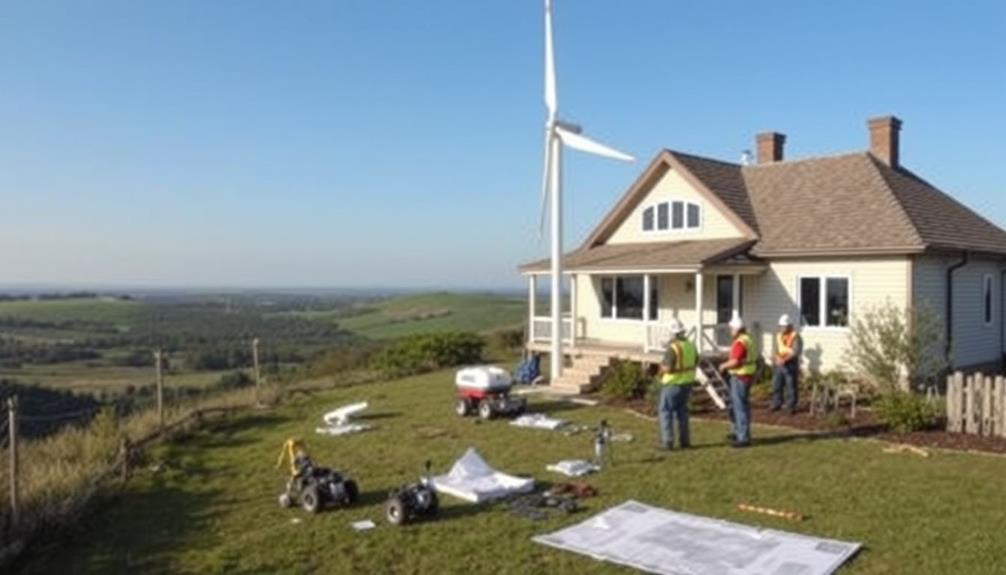
Before you install a wind turbine, you'll need to conduct a thorough site evaluation to guarantee you have the right conditions for ideal energy capture.
Evaluating the potential for energy efficiency can also help you understand the advantages of integrating systems like heat pumps for complementary energy solutions, which can greatly reduce your overall energy consumption energy-saving features.
Don't forget to check local zoning regulations and obtain the necessary permits, as these can directly affect your project's feasibility.
Proper planning at this stage is essential for a successful installation.
Site Assessment Importance
A thorough site assessment is imperative for guaranteeing your wind turbine operates efficiently and safely. First, you need to determine if the annual average wind speed at your installation location exceeds the minimum requirement of 9 mph. This speed is essential for effective wind turbine operation.
Evaluating geographical conditions is also important; you must ascertain there's a 30-foot clearance from any existing or future obstructions to achieve ideal wind capture. Many families enjoy unique vacation experiences at hotels with water parks, which can serve as a great example of how location and features can enhance overall satisfaction in a project. Additionally, water park amenities are often designed with specific geographical characteristics in mind.
Additionally, it's crucial to conduct a wind resource assessment. This professional evaluation provides accurate energy production estimates based on your specific site's wind patterns and characteristics.
Tailoring the foundation design to support the turbine's size and local soil conditions is another key aspect of your site assessment. A stable foundation guarantees safety during operation.
Before proceeding, don't forget to review local zoning laws, as they can vary greatly by municipality and may even prohibit wind turbine installations altogether.
Permitting and Zoning Regulations
Understanding local permitting and zoning regulations is an essential step in the installation process for your wind turbine. Before you proceed, you need to familiarize yourself with the specific requirements that can vary greatly from one municipality to another.
Some key points to take into account include:
- Zoning laws: These may restrict or prohibit wind turbine installations altogether. Be sure to check local regulations for potential funding options that might support renewable energy projects, such as assistance programs.
- Wind resource assessment: An average wind speed of at least 9 mph is necessary, and local regulations might require verification of this.
- Setbacks: Most municipalities impose a minimum distance from property lines, typically 1.5 to 2 times the turbine height.
- Public hearings: You may need to engage with local authorities, which can impact the timeline and overall feasibility of your project.
To guarantee compliance, you'll likely need to submit plans detailing your turbine specifications, the proposed location, and adherence to local codes and safety standards.
Maneuvering through these permitting processes diligently can make a considerable difference in the success of your installation, so take the time to research and prepare thoroughly.
Sizing Your Wind Turbine
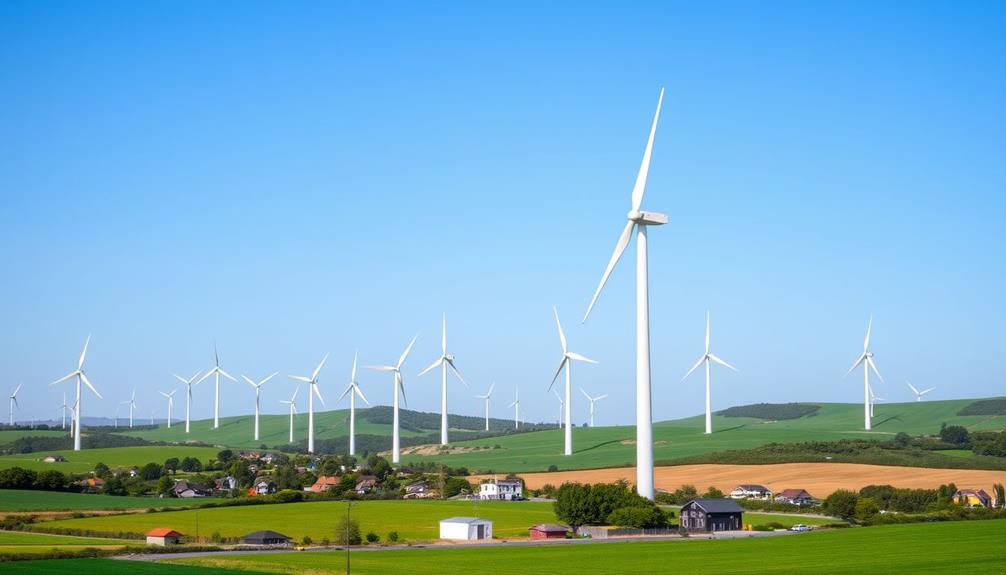
When sizing your wind turbine, it's essential to evaluate your average energy consumption. The typical U.S. home uses about 10,700 kWh per year, which means you'll likely need a turbine between 5 kW to 15 kW, depending on your local wind conditions. Conduct a wind resource assessment to guarantee your site has an average wind speed of at least 9 mph for effective turbine operation.
For instance, a 1.5 kW turbine can meet energy needs of around 300 kWh per month if the average annual wind speed is at least 14 mph. Additionally, understanding your budget for installation and maintenance can help you choose a turbine that fits your financial plan.
When sizing your wind turbine, consider the geographic conditions of your location. High-wind areas may allow for smaller turbines to effectively meet energy needs, while low-wind areas may necessitate larger units for sufficient power generation.
Professional installers can help you estimate energy production based on the turbine's power curve, average wind speed, and tower height, guaranteeing you choose the right model. By carefully considering these factors, you can make informed decisions that optimize your energy output and guarantee your power systems effectively meet your home's energy demands.
Maintenance and Troubleshooting
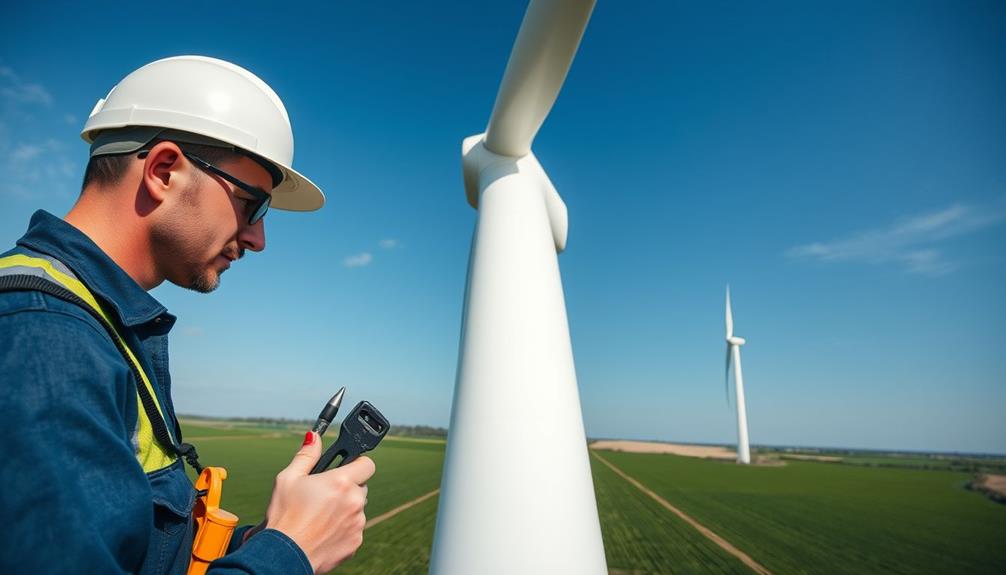
To keep your wind turbine running smoothly, you should schedule regular inspections every six months to a year.
This proactive approach helps catch common system issues early, preventing costly repairs down the line.
Additionally, understanding the importance of component maintenance can greatly enhance your turbine's lifespan, much like the benefits of professional cleaning over DIY methods in mechanic shops for fuel injection cleaning.
Regular Inspection Schedule
Regular inspections of your wind turbine system are essential for maintaining ideal performance and ensuring safety over time. Aim to conduct these inspections every 6 months to 1 year. This routine check-up helps you catch potential issues before they escalate, extending the lifespan of your system.
Additionally, just like with other appliances, preventive maintenance plans can notably contribute to the longevity and efficiency of your wind turbine.
Here are some key maintenance tasks to incorporate into your regular inspections:
- Check bolts for tightness: Loose bolts can lead to serious structural issues.
- Inspect for corrosion: Early detection can prevent larger problems down the line.
- Replace leading edge tape on blades: This helps protect against blade damage and wear.
- Lubricate moving parts: Proper lubrication is vital to avoid wear and tear.
Common System Issues
Wind turbines, while robust, can experience various system issues that may affect their performance and longevity. Regular maintenance is key to addressing these issues early. Common problems include blade damage, electrical faults, and tower corrosion.
Just like mastering the art of bug out bags, incorporating routine inspections and performance monitoring can catch these problems before they escalate.
It's vital to conduct inspections every 6 months to 1 year to guarantee your wind turbine operates efficiently over its lifespan of 20+ years. During these routine checks, inspect bolts for tightness, look for signs of corrosion, and lubricate moving parts to prevent wear and tear.
If you notice any operational issues, don't hesitate to reach out for expert support. Utilizing a maintenance contract can provide peace of mind, assuring timely troubleshooting and assistance.
Additionally, remember that proper installation is fundamental. A faulty connection sequence can lead to erratic behavior in your energy systems, resulting in performance issues and potential damage.
Economic Considerations
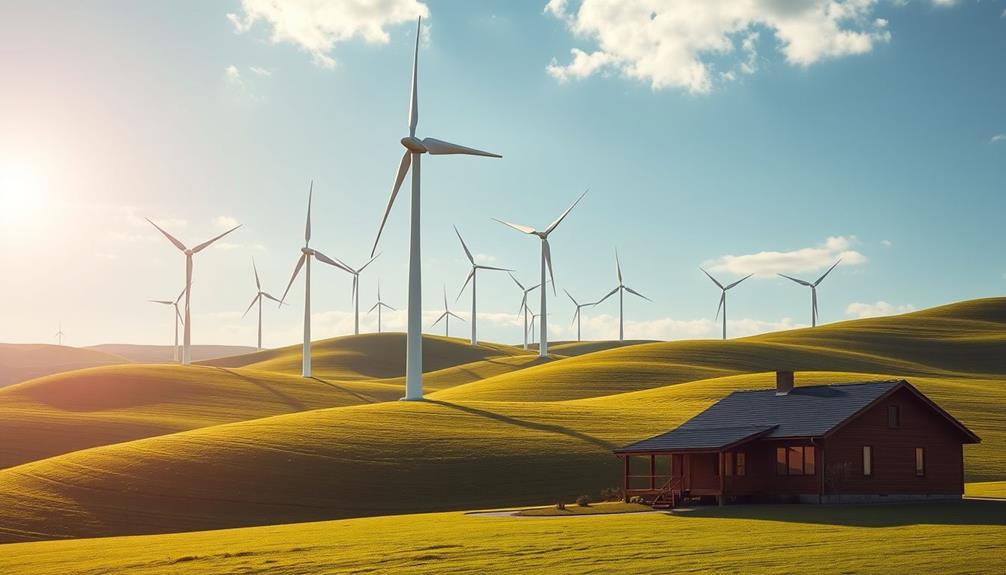
Investing in a small wind turbine system can be a significant financial decision for homeowners. The initial cost of these systems typically ranges from $3,000 to $8,000 per kilowatt, with full installations for average homes averaging around $50,000.
However, financial incentives, like federal tax credits, can cut installation costs by up to 30%, especially for systems under 100 kilowatts. Incorporating renewable energy solutions, such as wind turbines, can also enhance the overall sustainability of your home, similarly to how IRA rollovers to gold can diversify your investments.
To understand the economic viability of such an investment, consider the following:
- Payback periods can vary from 6 to 30 years based on energy savings and local utility rates.
- Homeowners can reduce their electricity bills by 50-90% after payback.
- Selling excess energy back to the grid can further enhance savings.
- A minimum average wind speed of 9 mph is recommended for effective energy generation.
Ultimately, while the upfront costs may seem intimidating, the long-term energy savings and potential to utilize renewable sources make small wind turbines an attractive option for environmentally-conscious homeowners.
Comparing Wind With Other Energy Sources
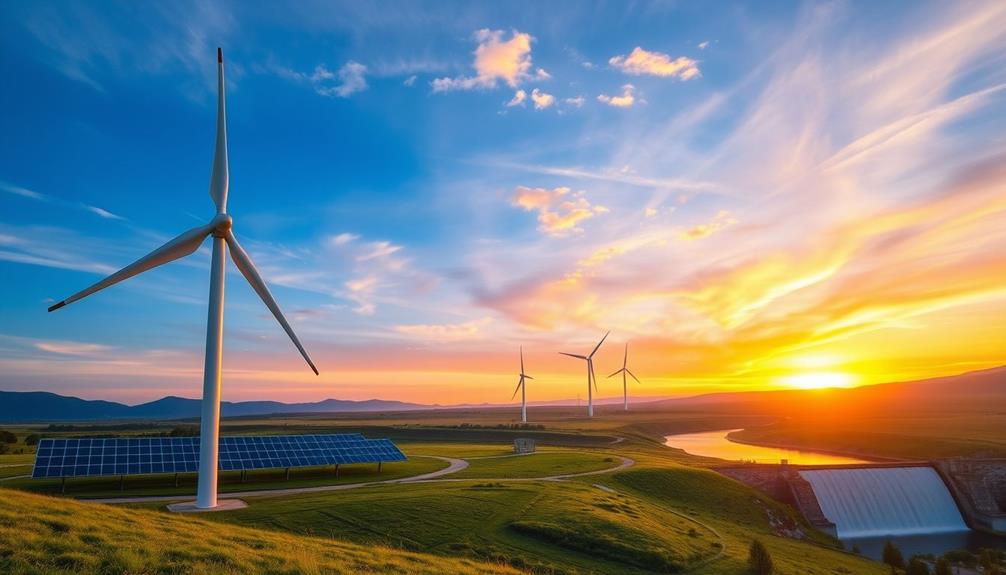
When comparing energy sources for your home, wind power stands out due to its impressive efficiency and potential for significant savings. Wind turbine power can achieve a theoretical efficiency of up to 59%, which is considerably higher than solar power's maximum efficiency of around 23%. This means that in areas with consistent high winds, you could harness more energy for residential use.
To meet the energy needs of an average American home, which consumes about 10,700 kWh annually, you'll typically need a 5-15 kW wind turbine operating in conditions with an average wind speed of at least 9 mph.
Unlike solar energy, which depends on sunlight, wind energy can be more reliable in diverse locations, minimizing environmental impacts compared to hydropower systems.
Moreover, combining wind and solar energy in hybrid systems enhances overall efficiency. While both are clean energy sources, integrating energy storage solutions with wind turbines can provide a more stable energy supply.
Frequently Asked Questions
How Big of a Wind Turbine Do I Need to Power My House?
To power your house, you'll need a wind turbine between 5-15 kW, depending on your energy consumption and local wind speeds. Assess your site's wind resources to determine the best size for consistent energy output.
Can I Power My Home With a Wind Turbine?
Sure, if you want to power your home with a wind turbine, just hope the wind blows like it's on a caffeine high! But seriously, it can help, just not completely. Consider your energy needs.
How Many Wind Generators Does It Take to Power a House?
To power your house, you might need one to several wind generators, depending on your energy consumption and local wind conditions. Assess your monthly needs and wind speed to determine the right number for you.
How Many Turns of Wind Turbine Does It Take to Power a House?
Did you know a small wind turbine needs an average wind speed of 14 mph to produce about 300 kWh monthly? To power your home, you'll likely need several turns and turbines working together efficiently.
Conclusion
In wrapping up your journey into harnessing wind energy, remember that embracing home wind turbines isn't just about saving on bills; it's about dancing with nature and enjoying the gentle whispers of the breeze. By choosing this eco-friendly path, you're not only nurturing your pocket but also giving Mother Earth a helping hand. So, as you set sail on this renewable adventure, you'll find that the winds of change can be your greatest ally at home!
